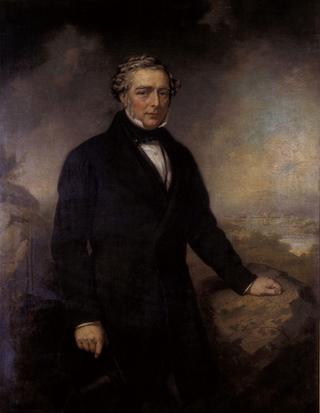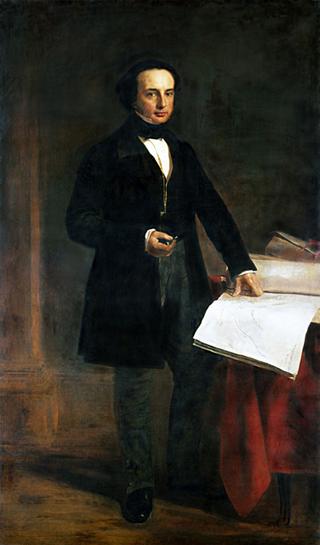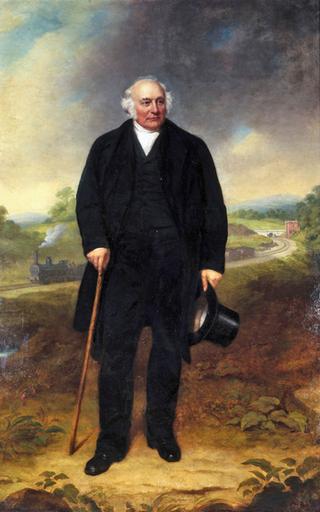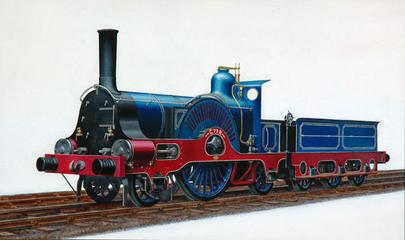
Drawing of Singhi Dalan in Rajmahal, Jharkhand, India
- Made:
- 1856-11
- maker:
- Alfred Harris Vaux




Drawing, ink and pencil on paper, Rajmahal Singhee Dalan by A Vaux, November 1856. Depicts the Singhi Dalan (Marble Pavilion) fort on the banks of the River Ganges in the town of Rajmahal. In the foreground a Bengali woman carries a pot of water on her head, while holding the hand of a small, naked child. At left in the river is a man rowing a small boat while in the distance another man fishes at the edge of the river. The title is given beneath the drawing. At bottom left is the inscription "Rajmahal Singhee Dulan, November 1856. A. H. V." At top right in pencil is the number 43. On the reverse, in pencil and pen, written over the top of an earlier inscription, are the words "Rajmahal. The Singhe Dulan or (old fort) Mahomedan Palace. Bungalow occupied by Mr Vigors district Engineers family etched by Mr Vaux + presented to F(?) T 1856 Dec-". The earlier inscription below appears to be the same, except that the F(?) appears to be a G. From the collection of George Turnbull, Engineer of the East Indian Railway. Unframed. The bottom left inscription is initialled by Vaux. The other inscriptions are in Turnbull’s hand.
Alfred Harris Vaux was a resident engineer on the East Indian Railway. This drawing was made in November 1856, at a time when there was turmoil on the line at Rajmahal. Turnbull wrote in his autobiography that one of the partners on the project ‘neglected his work’, while another ‘was quite incompetent’. As a result ‘the works came almost to a standstill’. The following month, on 21 December, Turnbull visited Rajmahal to examine the works – it was perhaps at this point that Vaux presented his drawing to Turnbull.
The Singhi Dalan was built either in the late 16th century by Raja Man Singh I, mughal emperor Akbar's viceroy in Bengal, or in the mid 17th century by Shah Suja, second son of mughal emperor Shah Jahan. By the 1850s the British were using it as the residence of the East Indian Railway district engineer and his family. Today, the building remains standing on the banks of the Ganges in the town of Rajmahal, and is a protected monument.
Scottish engineer George Turnbull (1809-1889) oversaw the creation of one of the first railways in India, the East Indian Railway (EIR). The EIR ran from near Calcutta (now Kolkata), an East India Company trading post in the north-east that the Company established as the capital from 1773. The terminus was originally Benares (now Varanasi), but the line quickly extended to New Delhi in the north, which became the capital of India in 1911. Calcutta and New Delhi are over 1,300km miles from each other – further than the distance between Paris, France and Budapest, Hungary.
Turnbull collected artworks during his time in India, many of which were produced by EIR engineers. These watercolours and drawings provide a rare view of nineteenth-century India from the perspective of the British engineers designing and building the country’s first railways. The collection includes landscape scenes and portraits. While many of the landscapes show the construction of the railway, others focus entirely on India’s local architecture or its rural spaces. The portraits are of people Turnbull encountered while in India. While the portraits of British people are inscribed with their names, most of the Indian people depicted remain anonymous or identified only by their job.
The British introduced railways in India to satisfy the mounting economic and military needs of their colonial administration. They hoped that the new technology would foster an increased sense of collective identity by making it easier to travel quickly between distant regions. They also hoped the railways would socially ‘improve India’ by instilling a sense of punctuality among Indians, a quality British colonialists believed Indians lacked. The racist stereotypes underpinning these intentions, and the interconnected idea that technology could trigger social change, were common beliefs in nineteenth-century British society.
Details
- Category:
- Pictorial Collection (Railway)
- Object Number:
- 2017-7095
- Materials:
- ink and paper (fibre product)
- type:
- drawing, pen




